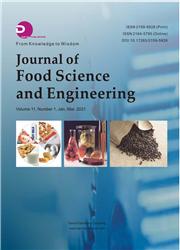Promising Peanut Lines in Northeastern Philippines
引用次数: 1
Abstract
: Peanut or ground nut ( Arachis hypogea L.) is one of the food legumes with commercial importance in the Philippines grown by farmers (with small landholdings) in most parts of the country. However, one of the major constraints to peanut is the lack of supply of good stocks coupled with modern production technology. To alleviate this problem especially in those areas planted to this crop is the development of improved lines, their evaluation to different locations and their maintenance for sustained production. Thus, the project aimed to adapt, evaluate, select and identify high yielding, disease-resistant and other desirable characters of peanut in northeastern Philippines particularly at Mariano Marcos State University (MMSU), Dingras, Ilocos Norte, conducted from July 2014 to May 2015. The different lines of peanut were arranged in a randomized complete block design (RCBD) replicated four times. Optimum cultural requirements from planting to harvesting were followed to permit expressions of the genetic potential of the different lines of the crop. During wet and dry season trials, results revealed significant differences in all treatments relative to pod and seed yield, seed size, shelling percentage and plant height except number of pods per plant, and days to flower and mature. The lines ICGV 00337, ICGV 95111, and ICGV 98371 out yielded the remaining seven peanut lines registering a pod yield of 1,860 to 1,020 kg/ha and had a yield advantage of 73% to 58.9%, respectively over the check variety Ilocos Red. Growing peanut in northeastern Philippines can approximately give an income ranging from Php87,120 to Php93,960 per hectare with a benefit/cost ratio of 2.02 to 2.19.菲律宾东北部有前景的花生新品系
:花生或花生(Arachis hypogea L.)是菲律宾大部分地区农民(拥有少量土地)种植的具有商业重要性的食用豆类之一。然而,花生的主要制约因素之一是缺乏良好的库存和现代生产技术。为了缓解这一问题,特别是在种植这种作物的地区,需要开发改进的生产线,对不同地点进行评估,并维持其持续生产。因此,该项目旨在适应、评估、选择和鉴定菲律宾东北部花生的高产、抗病和其他理想性状,特别是在马里亚诺-马科斯州立大学(MMSU),位于北伊洛科斯州丁格拉斯,于2014年7月至2015年5月进行。花生的不同品系以随机完全区组设计(RCBD)进行排列,重复四次。遵循从种植到收获的最佳培养要求,以允许不同作物系的遗传潜力的表达。在雨季和旱季试验中,结果显示,除单株荚数、开花和成熟天数外,所有处理在荚和种子产量、种子大小、脱壳率和株高方面都存在显著差异。ICGV 00337、ICGV 95111和ICGV 98371产量超过了其余7个花生品系,其荚产量为1860至1020公斤/公顷,产量优势分别为73%至58.9%,高于对照品种Ilocos Red。在菲律宾东北部种植花生每公顷可获得约87120至93960菲律宾比索的收入,效益/成本比为2.02至2.19。
本文章由计算机程序翻译,如有差异,请以英文原文为准。
求助全文
约1分钟内获得全文
求助全文

 求助内容:
求助内容: 应助结果提醒方式:
应助结果提醒方式:


